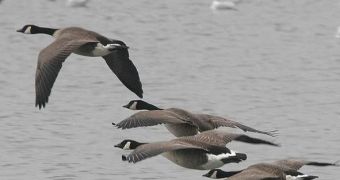65 % of the bird species migrate. Some species make very short displacements during winter, like the Finnish rooks which spend the winter in Northern Germany, displacing themselves with just 50 km (30 mi) daily.
The longest migration made by any bird is that effectuated by the Arctic tern (Sterna paradisaea), which nests on the Arctic zone, in the tundra region, and winters in the Antarctica (when there is the Austral summer). This 19,000 km (12,000 mi) journey ensures that this bird sees two summers per year and more daylight than any other creature on the planet. The American golden plover (Pluvialis dominica) nests in Alaska and winters in the Argentinean pampas, thus making a journey of 16,000 km (10,000 mi).
But even common birds in the temperate zones effectuate large migrations. The barn swallow (Hirundo rustica) flies from Europe to South Africa about 8-10,000 km (5-6,000 mi) and the common cuckoo (Cuculus canorus) migrates till south Africa or Australia some 7,000 km (4,000 mi).
Birds usually fly at 30-88 km (18- 52 mi)/h during the migration, making from 250 km (150 mi) to over 500 km (300 mi) daily. The northern lapwing (Vanellus vanellus) can fly continuously at 150 km/h (90 mi/h), crossing the Atlantic in 24 h.
Over the sea, birds fly at hundreds of meters, using sea currents. That's why the heart in case of these little birds counts for 10 % of their weight! But the small song birds also get tired often and need rest, that's why they avoid deserts, oceans or mountains during their migration. Some birds migrate during the daylight, like herons, storks, birds of prey, while others, like owls, cuckoo, woodcocks migrate during the night. Birds of prey and storks use thermal currents formed over the warm ground in their migratory flight.
As these currents form only during the daylight, they are forced to migrate only during this period. Geese, ducks and cranes migrate both during the day and night.
Birds that feed on grains or other vegetable items, eat during their migratory halts, but those that eat animal stuff (like pelicans, insectivorous, birds of prey, storks) usually do not, which means they accumulate fat before the great journey. They usually lose 25 % of their weight during the migration.
The question is: how do migrating birds compensate sleep loss? Researches showed in the case of flocks of wild ducks, the birds can take short naps during combining the resting of the whole brain with unilateral eye closure (UEC), when the birds rested one eye and one half of their brains while their other eye and brain hemisphere remained open and active, keeping them semi-alert to danger. Ducks found at the head of the line had half of their brain in UEC one third of the sleep time, while those in the middle of the flying line, just 12 % of the sleep time. When the situation is risky, birds were found to have more UEC episodes.
A research made in 2006 in Swainson's thrushes showed they too take hundreds of naps during the day, each of just a few seconds, to compensate the night sleep loss. This species have a migration route of 3,000 mi (5,000 km) from their breeding areas in northern Canada and Alaska to winter territories in Central and South America. They travel mostly during the night and often for long hours at a time, leaving little time for sleep.
During autumn and spring - the migration periods - they reverse their typical sleep patterns, staying awake at night and resting during day. The difference is that, instead of sleeping for long stretches at a time, the birds take several naps a day, of only 9 seconds on average. They too employ UEC. Drowsiness is characterized by a partial shutting of both eyes that still allows for some visual processing.
By alternating between naps, UEC and drowsiness, the thrushes and other migratory birds can reap some of the benefits of sleep while only marginally increasing their risks of being caught by prey birds. Drowsiness and UEC sleep are less effective than normal sleep, but they are safer. The idea that some birds can really sleep while in flight has not yet been proved, but the methods of decreasing the effect of sleep loss show that sleep loss cannot go on indefinitely.

 14 DAY TRIAL //
14 DAY TRIAL //